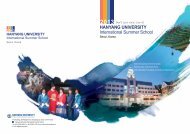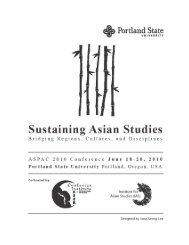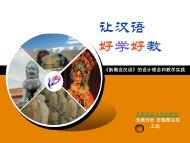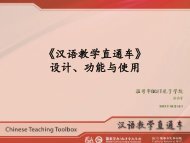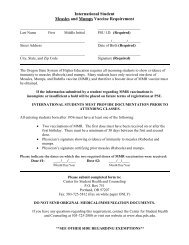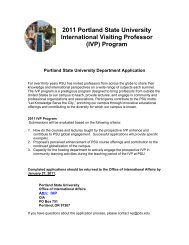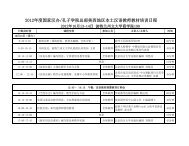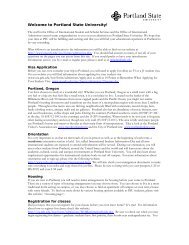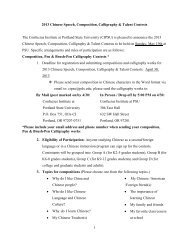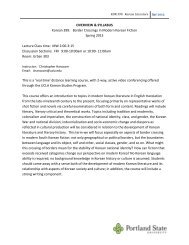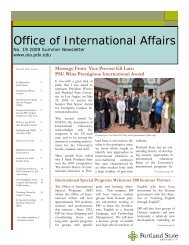ABSTRACTS - oia - Portland State University
ABSTRACTS - oia - Portland State University
ABSTRACTS - oia - Portland State University
You also want an ePaper? Increase the reach of your titles
YUMPU automatically turns print PDFs into web optimized ePapers that Google loves.
David Pietz<br />
Water and History on the North China Plain<br />
ASPAC Conference 2010<br />
June 18 – 20, 2010 | <strong>Portland</strong>, OR<br />
This paper will explore how the government of the People’s Republic of China managed the Yellow River<br />
after 1949. Specifically, the paper will formulate conclusions about the environmental consequences of<br />
different hydraulic engineering projects as China pursued different developmental paradigms during the Mao<br />
and post-Mao periods. The state pursued Soviet-style central planning for much of the 1950s, Great Leap<br />
Forward decentralization and communalization between 1958-1961, a blend of state planning and mass<br />
mobilization during the 1960s and 1970s, and “market socialism” during the post-Mao era (1978-). The<br />
project will be organized around these four eras and it will examine the implications that each of these<br />
developmental approaches had on North China’s water resources. Comparative conclusions about the<br />
environmental consequences of these four developmental periods will be guided by several fundamental<br />
options that faced state and party leaders throughout the post-1949 period: 1) modern hydraulic engineering<br />
vs. traditional water conservancy and mass mobilization, 2) central vs. local planning, 3) international technical<br />
cooperation vs. self-reliance, and 4) economic development vs. environmental protection.<br />
As China migrated to and from different developmental paradigms, the fundamental goal of building<br />
“wealth and power” remained consistent. Central to all these differing modernizing approaches was the<br />
effective management of water. Flood control, transportation, irrigation, hydroelectric generation, and<br />
pollution control were water management issues that the state sought to address. The challenge of the<br />
Chinese state after 1949 has been to formulate effective institutional patterns and policies to effectively<br />
manage water to serve modernizing goals. At the same time, however, many of these institutions and policies<br />
have had unexpected consequences on the same resources they sought to maximize.<br />
The paper will suggest the potential environmental consequences of water policy choices that were<br />
made in China. Whether the issues in centralization versus decentralization, reliance on contemporary<br />
standards of hydraulic engineering versus traditional mass mobilization, or self-reliance versus international<br />
cooperation, an examination of the experience of water management in China since 1949 will point to the<br />
environmental consequences of hydraulic engineering choices.<br />
~ ~ ~ ~ ~ ~ ~ ~ ~ ~<br />
John Porter<br />
Cholera 1886: Poverty, Disease and Urban Governance in Meiji Osaka<br />
This paper examines the relationship between poverty, disease, and urban governance in Osaka’s largest late<br />
nineteenth-century slum, Nagomachi. Characterized throughout the nineteenth century as a principal source<br />
of urban crime and social instability, during the 1880s Nagomachi came to be identified in both popular and<br />
official discourse as a “den of squalor and disease.” Citing public health concerns, in 1886 the Osaka<br />
prefectural government unveiled a citywide slum clearance proposal, which sought the demolition of the city’s<br />
largest slums and the relocation of Osaka’s poor to a walled residential compound on the city’s periphery.<br />
Announced at the height of the deadliest cholera epidemic in Japanese history, the proposal’s primary target<br />
was Nagomachi’s built environment and the “paupers and thieves” that found shelter in its flophouses and<br />
back-alley tenements.<br />
Focusing on proposals, such as the one described above, much of the scholarship on poverty in<br />
modern Japan has characterized the relationship between the urban poor and local government primarily in<br />
terms of discrimination and social exclusion. While it is certain that efforts were undertaken during the late<br />
nineteenth century in a number of Japanese cities to segregate the poor from other parts of the urban<br />
population, this paper argues that such efforts were paralleled by a broader “civilizing” project, which aimed<br />
not to exclude the poor, but to transform them into healthy, productive and docile citizens capable of<br />
contributing to the growth and prosperity of the Japanese nation.<br />
~ ~ ~ ~ ~ ~ ~ ~ ~ ~<br />
33



